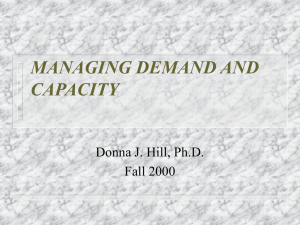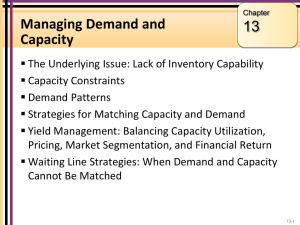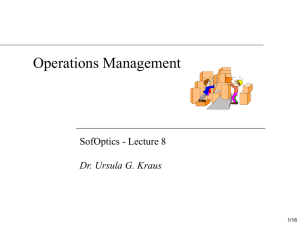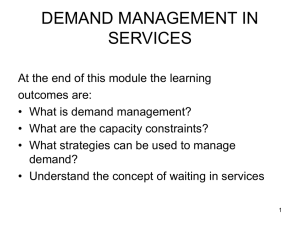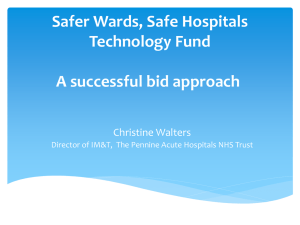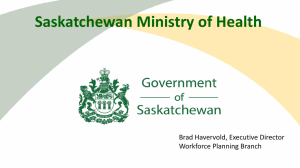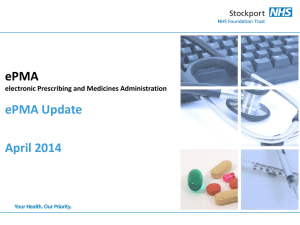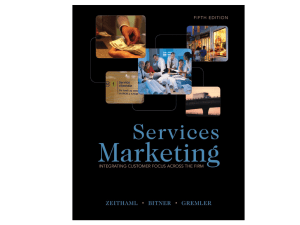Blank template for Better for You presentations
advertisement
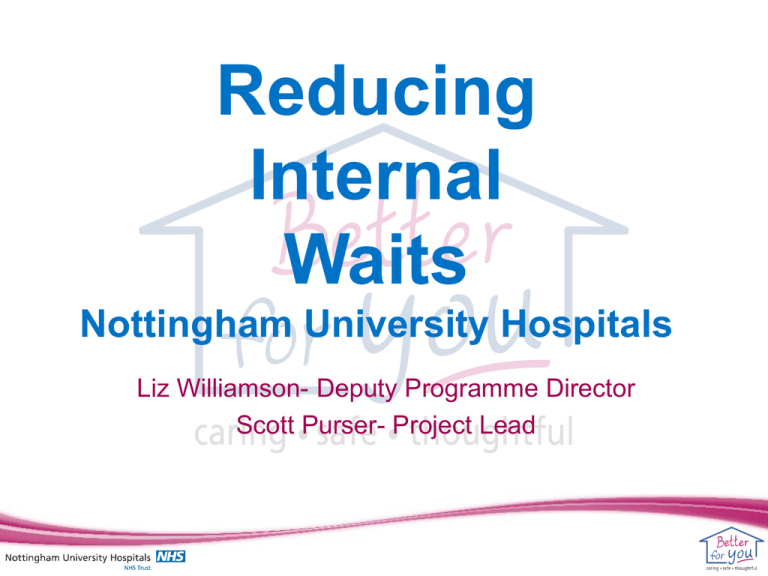
Reducing Internal Waits Nottingham University Hospitals Liz Williamson- Deputy Programme Director Scott Purser- Project Lead What we plan to cover today • The NUH improvement programme • Why this was important • Getting started • Discovery • Toolkit • Rollout • How we captured the benefits • Developing the toolkit • What the Future holds • Reflections Our hospitals City Hospital: largely elective & chronic care centre (including cancer) QMC: our emergency site (Emergency Department & trauma centre); Children’s Hospital Our vital statistics • Turnover £755 million • Circa 1,700 beds and 87 wards • Over 13,000 staff & 1,200 volunteers • 180,000 A&E attendances and 96,000 admissions • 66,000 day cases and 24,000 elective operations Our whole hospital improvement programme is called “Better for You” • Started in 2009/10, Better for You is our most comprehensive improvement programme • It is a quality driven programme, which releases financial savings • Currently, 250+ projects across the organisation, directly involving 2000+ staff • Change, which is caring, safe and thoughtful • The key feature is staff and patient engagement We developed the Better for You 5 Step Process – where staff engagement is key Set Up and Plan Discovery Design & Trial Implementation Embed Engage with stakeholders & establish scope – Identify potential benefits - Set up Team & Hub Identifying the issues and problems to be solved from every perspective – staff views, patient views, ‘business data’ Testing Future state in a real environment – Agree Plan Do Study Act – Assess whether trials deliver benefits Controlled implementation &/or roll out of future state and realisation of benefits identified Ensure changes are sustainable – full handover into operational environment – Knowing How We Are Doing Why did we need to reduce patient waits? • Good quality care is helped by good patient flow – Improvements to the Emergency Pathway relies on consistent ‘pull’ from the specialties • To meet some of our formidable challenges (activity, £££) – We needed to shrink our in-patient capacity (“more with less”?) • We respect patient’s time and do not want to keep healthy people in hospital – We want patients to have a positive experience – Some staff have learnt to accept/not challenge internal waits • Research says hospital stays can create safety issues • In-patient/hospital care is a scarce and expensive resource Aim and Scope of the project • Identify where and why waits occurred – Identify opportunities to work differently and/or smarter – Support directorate CIP plans • Reducing LOS • Reducing in-patient beds • Reduce the number of waits by 5080% • All adult wards Point us in the direction of where the opportunities for improvement might be Discovery started with a 4 week data collection of internal waits The size of the problem The opportunities for improvement What patients were waiting for, where and for how long Extensive analysis of data Identified a group of staff to undertake data collection as part of their existing role From this data, we found that ‘internal’ waits made up 40% of all waiting time We found that every day, we had on average: •117 patients waiting for Internal (average 117 patients per Internal (average 117 patients per day) internally provided services day) • Average wait for internal External (average services = 487days Average number of beds occupied per day by 'waiters' externally provided services •Average wait for external services = eight days External Internal (476 bed Internal External days) City patients per day) • 87 patients waiting for Internal QMC 0 20 40 60 80 100 Internal City 50 QMC 40 External 34 72 120 12.0 60.0 10.0 50.0 8.0 40.0 6.0 30.0 4.0 20.0 2.0 10.0 0.0 0.0 Imaging Echo Angio Specialty bed Psychiatric bed (e.g. B50, A23) Specialty review Therapies Family decision Beds (cumulative) Beds Top eight waits accounted for 50% of bed occupied by patients ‘waiting’ Beds Cumulative Data analysis proved to be very complex! The data was analysed by specialty, wait and opportunity We calculated baseline and stretch targets for bed reductions Clinical judgement was used to determine the ‘% of time waiting’ that could be ‘released’ Base target for internal waits 95 beds Base target for external waits 118 beds Stretch target for all waits 279!! Internal = 149 External = 130 If every wait on every day is included Also includes estimations for wards not included (NB assessment wards, maternity) We needed a message which created shared drive for (the need for) change • Patient safety is paramount • Financial imperative to reduce costs An in-patient wait is a wasted resource and exposes patients to unnecessary risk We took the decision early on that we needed to ‘do something’ across the trust and at pace • Set up a Steering Group – initially chaired by the Deputy CEO/DoN • Key involvement – Medical Director, senior nurses • Early involvement with other improvement projects (imaging, heart services) 14 We created a ‘toolkit’ of actions which would help us reduce internal waits Status at a glance Daily board round Escalation process The toolkit included: • key principles of each of the 4 components • ‘how to’ section • glossary of terms Problem solving and resolving waits Daily Board Round is at the heart of the process How to set up.......................and lead a daily boardround Identify a time for board round (eg 8am, 9am etc) Identify essential MDT members who need to attend daily board rounds Inform essential MDT members of their roles and responsibilities when participating Set a date to commence board rounds and invite essential MDT members The identified lead for board round begins discussions by asking for each patient: What is the patient waiting for today to progress their care? Has the referral been made? When do we anticipate the patient will be medically stable? What is the predicted discharge date? Identify patients who are: Sick Being discharged Waiting for tests and diagnostics Status at a Glance At the time we had a mix of electronic and manual white boards - we had to standardise the layout Who is Who is medically stable? Is the patient medically stable/fit (y/n) i.e. do they need an acute medical bed Expected date the patient will no longer require an acute hospital bed. This should be reviewed daily by medical teams and should not incorporate any delays/waits Medically stable y/n Predicted medically stable date Name Consultant Nurse R1 Ann Other AA1 Jenny X R2 Jean Smith AA1 Jenny y R3 And so on…. BB2 Jenny y R4 CC3 Jenny y R5 AA1 Jenny y R6 CC3 Jenny n B1 AA1 Jane n B2 AA1 Jane y B3 CC3 Jane n Bed ready for discharge? What are patients waiting for? 05-Jan 02-Jan 01-Jan 03-Jan Date patient is expected to actually be discharged. For most patients this should be the same as This should be since the medically fit date but admission to hospital for some e.g. patients waiting Lings Bar, it may be different Predicted Discharge DateLOS (since admission) Destination 06-Jan 3 1 2 3 B5 B6 CC3 BB2 AA1 Jane Jane Jane H H Waiting for (incl date/time of ref) TTO Social worker Occ Therap Physio 24 hour tape (4.1.10 9am) TTO Needed Needed Needed Ultrasound (4.1.10) TTO Complete Complete NH OT assessment (referred 5.1.10) TTO H Social services assessment (4.1.10) TTO Internediate Care (2.1.10) TTO 02-Jan 4 CITY 03-Jan 1 H 02-Jan B4 Please list all the things that the patient is waiting for and the date referred. Codes/suitable abbreviations should be used if your board is Optional column headings in a public area H Jenny31/12/08 0815 Complete Jenny31/12/08 0815 Complete Jane 31/12/08 0830 Complete Jane 31/12/08 0830 09-Jan 1 H 01-Jan 3 H TTO Complete Needed Complete 03-Jan 3 H TTO 03-Jan 4 NH TTO 02-Jan 3 H TTO 04-Jan 2 H TTO 02-Jan 1 H TTO 01-Jan 3 CITY TTO 03-Jan 3 H TTO Jane 31/12/08 0830 Jane 31/12/08 0830 n BB2 Sarah y BB2 Sarah y G3 CC3 Sarah n G4 AA1 Sarah y SR1 CC3 Jenny n SR2 BB2 Jane y 10-Jan 2 H Jane 31/12/08 0830 Jane 31/12/08 0830 n G2 Jenny31/12/08 0815 Jenny31/12/08 0815 Referred y G1 Jenny31/12/08 0815 Jenny31/12/08 0815 Referred TTO TTO Updated by (date, time, initials) Complete Referred Needed Complete Complete Complete Needed Sarah 31/12/08 0830 Sarah 31/12/08 0830 Sarah 31/12/08 0830 Sarah 31/12/08 0830 Complete Jenny31/12/08 0815 Jane 31/12/08 0830 06-Jan 1 H Problem Solving Identifying waits at board round • encouraged the MDT/ward staff to be pro-active in resolving waits themselves, at an earlier stage • gathered on-going data on the top waits • enabled us to focus improvement efforts in the right areas Examples of some of the waits identified at board round A CT scan requested yesterday at 10am and not done by 10am today Waiting more than 24 hours to move to another ward/specialty Waiting for a decision to progress the patient’s journey from a senior decision maker An investigation that is only undertaken on a Wednesday and today is Friday Waiting more than 24 hours for a review from another specialty after referral Waiting for TTO’s to be prescribed Therapy assessment more than 24 hours after referral Referrals made on Friday but not done until Monday (due to a 5 day service) Escalation Process for wards Aimed to get the right people involved at the right time – not too early, but not too late! Wait occurs Resolved by ward staff Key role for matrons Wait occurs frequently Resolved by ward staff Ward staff inform matron of theme Wait occurs Ward staff unable to resolve Ward staff inform matron of theme Wait occurs Ward staff unable to resolve Ward staff inform matron of theme Matron informs Clinical Lead during daily meeting Issue taken to internal waits steering group for investigation Matron resolves Matron unable to resolve Matron informs clinical lead during daily meeting Feedback loop at all stages of the process Clinical lead resolves or takes to internal waits steering group We planned a comprehensive rollout across 60 wards – took a team of 8 people 4 months to complete 1 week preparation with B4Y project lead, Matrons, Clinical Lead and Head of Service for each directorate 2 weeks intensive support per ward within directorate from B4Y team member (supported by B4Y project lead) 2 weeks light touch to all wards within the directorate from B4Y project lead. B4Y team members move to next directorate B4Y project lead remains named contact for directorate until end of rollout Training Team – from Better for you and Productive Ward Mostly senior nurses – plus an OT! 1-2 hours per day We designed a daily manual checklist to capture data on process steps and waits Recorded daily and submitted at the end of each week - one form for each ward Process measures •Board round undertaken •Senior decision maker present •LOS graph plotted •Waits escalated •Cause of waits review undertaken + details of waits Hugely time consuming to collect and analyse (but crucial) After 6 months, these forms were individualised for each ward, based on their top waits Every week we reported the total number of internal waits (in patient-days) and the average number of pt-days per form/ward Bed reduction programme commenced 96 beds We created a dashboard for every ward ward, which updates automatically What was achieved during Phase 1 Implement Toolkit on all medical and surgical adult wards Reduce the number of internal wait Patient days by 50% (min); 80% (max) All adult wards (n=56) implemented the toolkit Other benefits: • Reduction in Internal waits reduced from 750 (July 2010) to 260 (October 2011) = 66% reduction Reduce LOS to support closure of 95 beds 96 beds closed were during March/April 2011 across both campuses Reduce outliers to zero Reduced from a high of 120 during February 2011 to around 15-20 in October 2011 number of inappropriate cardiology Investigations (24 hour tapes for in-pts) • Enhanced patient experience through fewer unnecessary waits Impact on top 4 waits... Imaging Imaging Cardiology Cardiology Dropped Droppedfrom from baseline baselineof of 172 172 inMarch March to to an an in averageof ofaround around90 90 average Reduced Reducedfrom fromaabaseline baselineof of112 112 inMarch March to to an an average average of of in around 40 40 around Ward processes Specialty Bed Reduced from a baseline of 128 in March to an average of around 25 Reduced from a baseline of 100 in March to an average of around 35 There were Better for you projects running concurrently in Imaging and Cardiology – this was crucial in being able to affect changes in these complex areas Successes from the Services Imaging: % of in-patient ultrasound scans completed within 24hrs of request Before: 60% After: 98.8% Cardiology: % of in-patient ECHOs completed within 24hrs of request Before: 58% After: 98% How staff felt about the project... You have won me over! I didn’t think it would make a difference but it has! Being able to see how long patients have been in hospital is a real eye opener I can now tell my patients what’s going to happen next and when we’re planning for them to go home We have tried to improve our communication as a team for a while now - a daily board round has given us the ability to progress this Reducing Internal Waits The Future At the end of Phase 2 (18 months on) • We had evidence that reported waits had reduced by a further 20% (NB using a more robust SPC approach now!) • Evidence that the culture of accepting waits as unavoidable was no longer the ‘norm’ • Most wards had a board round, but.. – Not all had a senior decision-maker – Role of matrons had become less visible – We weren’t identifying enough of the remaining waits • We really wanted a better KHWD approach A new Data Analyst brought a new set of skills to our analysis, expanding use of SPC charts We needed to be able to more accurately detect ‘process change’ and not react to normal variation Moving into Phase 3, our aim was Eradicate unnecessary waits to: • improve patient experience and safety • ensure our patients have the smoothest journey possible through our hospitals and services • improve capacity/flow Some of the main changes in the third phase include Waits of < 1 day (including TTOs) Increase service responsibility for ‘pull’ Re-focus board rounds Status at a glance Safety & flow round Escalation process Problem solving and resolving waits During spring 2012, we realised we had ‘plateaued’ – so we re-design the toolkit and re-launched it We have refocused the board round on Safety & Flow Nurse Nurse in charge • Overnight events • EWS & pain control • Outstanding investigations or delays • Falls assessment /Braden and grade • Facilitate board round and update Horizon • Ensure unexpectedly poorly & unreviewed are discussed first • Agree who is responsible for actions • Ensure identified waits are escalated/resolved Senior Decision Maker • Delegate Dr to review unexpectedly poorly /unreviewed patients • Review all requested investigations • Is patient progressing as planned? • Review PDD & MS • Ensure correct consultant is allocated to patient Therapy team Doctors • Identify patients who require input • Identify and report any delays to assessment/input • Identify which patients need to be seen first • Check investigations on Notis • Identify which patients require ETTO’s commencing • VTE assessment required Board Round The toolkit was re-developed using an approach developed by lead cardiologist and his ward team S ICK pts Patient needs to be seen by a senior decision-maker now – deteriorating, overnight/ un-reviewed admission H OME pts Today’s discharges O ther pts All other patients LAN Incoming patients and outliers from our ward Weekend Plans Do our patients have a plan of care which is known to all key individuals? “How do we know we have run a successful Safety and Flow Board Round?” P Is everyone aware of what actions are required to deliver each plan of care? Is all the information about each patients correct, including the consultant? On Friday is there a plan for the weekend including nurse facilitated discharge? Have waits been identified? Who is responsible to for resolving them? Could any outstanding investigations/tests be done as an outpatient? S a f e t y & f l o w We have improved and expanded data analysis By Directorate By Ward By Service Imaging and cardiology waits have (more than) halved - but are still the biggest cause of waits Our Current Challenges! • Reduce the number of internal waits by a further 20% in six months • Harness the opportunities of our new electronic bed management system • Waits measured in hours not days • Escalation plans for the top 5 services • Electronic data collection • Integrate Internal Waits ‘processes’ to daily capacity/flow meetings Some reflections (or “what we would do differently if we could”!) It was (and is) tough To get started...... To create the drive for change..... To get enough of the ‘right’ people involved and actually helping..... Getting the cultural change from the bottom up..... But it has made a huge difference • It’s part of ‘our’ language now • Board rounds are an accepted part of everyday life (doesn’t mean they always happen though!) • Some wards have taken to the concept well and easily, others......... • Most of our services have responded very positively and pro-actively to reducing waiting times What would we do differently? • Get matrons much more actively involved from the start – Including training & rollout • Get better and quicker feedback for wards regarding their performance • More medical staff involvement throughout • Integrate into everyday systems more quickly • Manage poor performers more robustly • Early involvement from services – creating the pull Questions? Thoughts? Comments? Liz Williamson: liz.williamson@nuh.nhs.uk Scott Purser: scott.purser@nuh.nhs.uk 7
